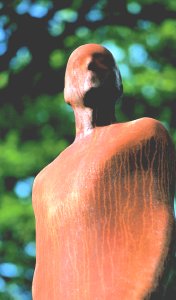
Alex Hodby suggests that art in the open air offers a new way of looking at the landscape around us, as well as the art itself.
To discuss the presentation of visual arts outside the more traditional gallery space depends on a clear definition of what that ?other space? might be. In this instance, we are literally talking about the outside ? the open air ? and, specifically, the 18th century landscape of Bretton Hall, in which Yorkshire Sculpture Park (YSP) has been situated for 28 years, since being founded by the current Executive Director, Peter Murray.
Over that time, YSP has advanced the technical and curatorial skills involved in making exhibitions beyond the gallery, pivoting major international exhibitions around its unique landscape setting. There have been shows of Moore, Frink, Rodin, Bourdelle, Hepworth, Marini, Chillida and Caro: major figures from the past century or more of sculpture. Each has transformed the landscape with the presence of spectacular objects, showing them to a growing audience, with funding from diverse sources. Some works from these shows have generously been allowed to remain at YSP, and, in unison, they create a core collection of significant sculptures. The nature of these pieces means that virtually everything seen at YSP is temporarily sited: some works may remain for years, but will ultimately move, making way for new projects or presenting a new way to see an old favourite. All that happens in an indoor gallery space happens in the open air, but on a much larger scale. Works are inched into place, the fall of the land is adjusted to accommodate a base, and new routes to previously inaccessible parts of the Park are created.
YSP-initiated projects, often involving the commission of new work, have revealed the landscape in different and surprising ways. They have commented on the politics or philosophy of YSP?s situation, or by simply taking a step back, have shown us what happens right under our noses. YSP?s landscape means that our audience is diverse: some visitors come to walk as much as to look at sculpture, or to appreciate the birds or trees.
Specific projects have different effects. Greyworld?s Playground sound installation defines and questions the meaning of an iron pergola, but also allows visitors to sit and play. New projects by Alec Finlay describe walks and place poems in the landscape, and movement artist Simon Whitehead is making illuminated night walks. These projects encourage visitors to consider the flora around them and to think about their journeys around the Park. New commissions, such as Voyager (2001) by Dalziel + Scullion, located aluminium casts of mountain tents near to the rhododendrons of Himalayan origin. The tents were safely pitched in a garden, but hinted at that desire to consider exotic exploration: a meaning more difficult to convey in a clear, clean indoor context.
The need for indoor spaces to display art has not been sidelined: a new 600m2 Underground Gallery opened with a retrospective of work by William Turnbull; and Longside Gallery, shared with the Arts Council Collection of sculpture, is currently showing Antony Gormley?s ?Field for the British Isles?, from the collection. Alongside the smaller Bothy and Garden Galleries, this creates a dialogue with the landscape, allowing curators and artists to challenge themselves and visitors with the unique properties of each kind of space, exhibitions often have indoor and outdoor elements. Work to create and maintain these indoor spaces is as important as that which helps preserve and maintain the 500 acres of outdoor space at YSP.
The technical challenges of placing sculpture in the open air are (usually) surmountable: cranes, temporary roadways, unseasonal weather, can be planned for, and fundraising meets the unique requirements of installation on an outdoor scale. What comes with experience is the ability to place sculpture against the sky, trees, or a horizon, and also to work with artists willing to take up the challenge of working outside the gallery, albeit within a tended, bounded landscape. Most of the artists with whom we develop projects present their works in national and international galleries and museums. YSP offers a unique situation and inspiration for artists, who are given the support of dedicated staff with wide-ranging skills: from arboriculture and landscape history, to mapping and abseiling. YSP has stunning settings for sculptures made for the open air, but also plenty of diverse terrain in which idea of art in the landscape can be explored and questioned.
Alex Hodby is Deputy Curator at Yorkshire Sculpture Park. t: 01924 832631;
w: http://www.ysp.co.uk



